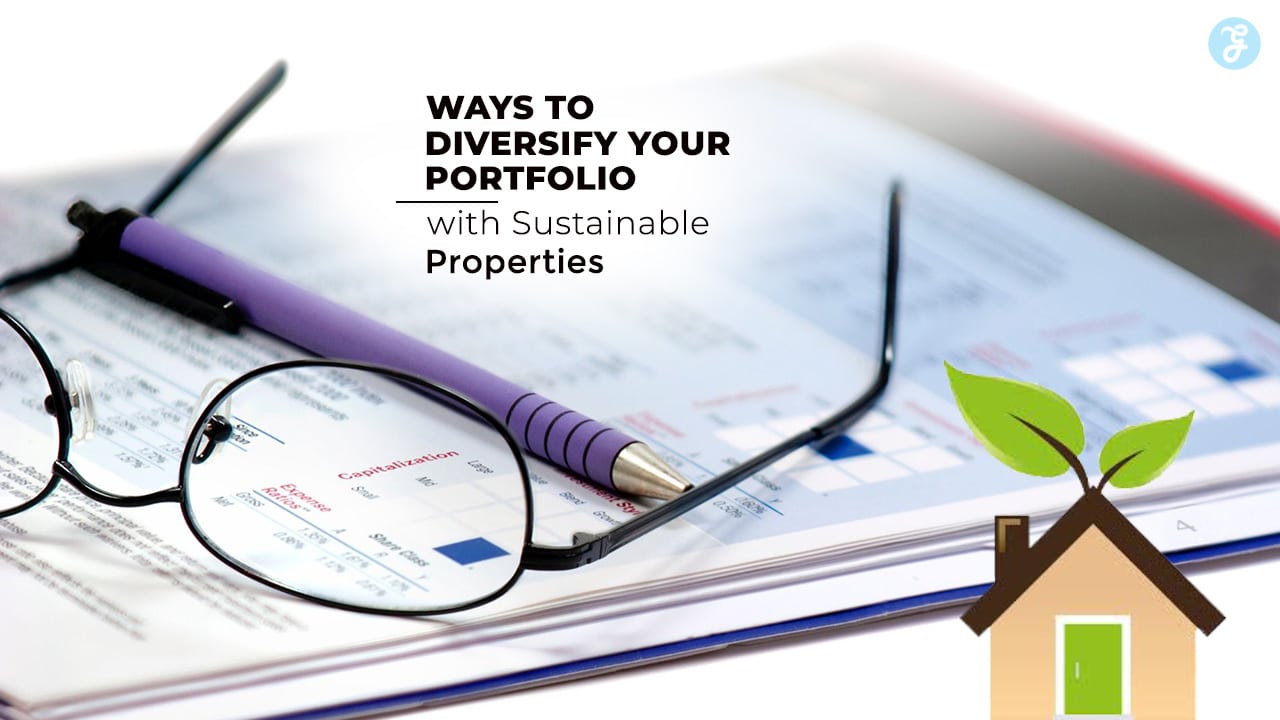Diversifying your portfolio is a cornerstone of smart investing, and sustainable properties are increasingly becoming a key asset class for forward-thinking investors.
These eco-friendly investments not only provide financial returns but also contribute to environmental preservation and align with global sustainability goals.
This guide explores 10 actionable ways to diversify your portfolio with sustainable properties, offering insights into their benefits, strategies for investment, and practical tips for getting started.
Why Sustainable Properties Are a Smart Investment Choice
The Rise of Sustainable Real Estate
Sustainable real estate has seen exponential growth over the past decade. As climate change and resource scarcity dominate global discussions, green building practices and eco-conscious developments are becoming more prevalent.
According to a 2023 report by the Global Real Estate Sustainability Benchmark (GRESB), investments in sustainable properties grew by 15% compared to the previous year, underscoring the rising demand for eco-friendly assets.
Benefits of Investing in Sustainable Properties
- Lower Operational Costs: Sustainable properties feature energy-efficient designs and renewable energy sources, reducing utility expenses for tenants and owners.
- Higher Property Value: Studies indicate that green-certified properties often command a premium price in the market.
- ESG Alignment: Environmental, Social, and Governance (ESG) considerations are increasingly influencing investor decisions, making sustainable properties a top choice for meeting these goals.
Key Advantages of Sustainable Properties
| Benefit | Description |
| Cost Savings | Energy efficiency reduces operational costs. |
| Increased Market Value | Green certifications add to the property’s desirability and resale value. |
| Tenant Appeal | Eco-conscious tenants prefer sustainable living or working environments. |
| Government Incentives | Tax credits and subsidies for green building practices. |
10 Strategies to Diversify Your Portfolio with Sustainable Properties
1. Invest in Energy-Efficient Residential Properties
Energy-efficient residential properties are ideal for investors looking to start small. These homes often include features like solar panels, energy-efficient windows, and smart thermostats, which attract environmentally conscious buyers and renters.
Beyond cost savings, these properties enhance comfort, reduce environmental impact, and meet the growing demand for sustainable housing.
Example: A net-zero home in California equipped with rooftop solar panels and energy-efficient appliances can reduce utility costs by up to 50%, increasing its market appeal.
Features of Energy-Efficient Homes
| Feature | Benefit |
| Solar Panels | Reduces electricity costs and reliance on the grid. |
| Energy-Efficient Windows | Improves insulation, lowering heating and cooling expenses. |
| Smart Thermostats | Enhances energy management and reduces waste. |
| Low-Flow Water Fixtures | Reduces water consumption and utility bills. |
2. Explore Commercial Green Buildings
Commercial green buildings are a growing segment in sustainable real estate. LEED-certified offices and retail spaces not only reduce environmental impact but also appeal to businesses aiming to enhance their ESG profiles.
Investors benefit from reduced vacancy rates, long-term tenant retention, and higher rental income compared to non-green commercial properties.
Benefits:
- Reduced operating costs through energy-efficient systems.
- Attracting eco-conscious tenants who value sustainability.
Example: A LEED Platinum-certified office in New York City reported 30% lower energy consumption compared to traditional buildings, making it a lucrative investment.
Benefits of Commercial Green Buildings
| Benefit | Description |
| Lower Energy Costs | Efficient systems reduce utility expenses. |
| Higher Tenant Retention | Businesses value green credentials and long-term savings. |
| Increased Lease Rates | Premium rents for eco-certified spaces. |
| Tax Incentives | Federal and state programs encourage green building investment. |
3. Diversify with Agricultural Land for Sustainable Farming
Sustainable farming practices are gaining traction, offering opportunities for investors to capitalize on the demand for organic and locally sourced produce. Properties that support regenerative agriculture can generate steady income while benefiting the environment.
Sustainable agriculture also increases biodiversity, improves soil health, and reduces carbon emissions, aligning with global sustainability goals.
Example: An organic farm in the Midwest focusing on no-till farming methods and crop rotation increases soil fertility and provides long-term value.
Practical Tip: Look for properties with access to water resources, fertile soil, and proximity to markets to maximize returns.
Key Factors in Sustainable Agricultural Investments
| Factor | Importance |
| Soil Health | Ensures long-term productivity and crop quality. |
| Water Access | Critical for irrigation and consistent yields. |
| Market Proximity | Reduces transportation costs and carbon footprint. |
| Certification Opportunities | Organic or fair-trade labels increase marketability. |
4. Invest in Renewable Energy Properties
Properties integrating renewable energy sources, such as solar farms or wind turbine installations, offer long-term profitability. These investments align with global clean energy initiatives and often benefit from government incentives.
As demand for clean energy continues to grow, renewable energy properties present a lucrative opportunity for forward-thinking investors.
Example: A solar farm in Nevada generates consistent revenue by selling electricity back to the grid under Power Purchase Agreements (PPAs).
Types of Renewable Energy Properties
| Property Type | Revenue Model |
| Solar Farms | Sell electricity via PPAs. |
| Wind Turbines | Generate income through renewable energy credits. |
| Geothermal Energy Sites | Provide heat and electricity to surrounding communities. |
5. Consider Mixed-Use Developments with Green Features
Mixed-use developments combine residential, commercial, and retail spaces, often incorporating sustainable features like green roofs, energy-efficient lighting, and urban gardens.
These properties cater to modern urban lifestyles and reduce the need for long commutes, promoting eco-friendly living. Such developments appeal to diverse tenants and provide multiple income streams for investors.
Example: A mixed-use development in Portland integrates rooftop gardens and rainwater harvesting systems, attracting tenants and reducing operational costs.
Green Features in Mixed-Use Developments
| Feature | Benefit |
| Green Roofs | Reduce heat islands and improve insulation. |
| Urban Gardens | Enhance aesthetics and provide fresh produce. |
| Rainwater Harvesting | Lowers water consumption and costs. |
| LED Lighting Systems | Reduces energy usage and maintenance expenses. |
6. Participate in Green REITs (Real Estate Investment Trusts)
Green REITs offer a hassle-free way to invest in sustainable properties. These trusts pool funds to invest in eco-friendly real estate, providing diversification and liquidity to investors. Green REITs focus on various property types, including LEED-certified buildings, energy-efficient apartments, and sustainable industrial spaces.
Example: A top-performing green REIT focusing on LEED-certified commercial spaces in urban centers offers stable dividends and long-term growth.
Advantages of Investing in Green REITs
| Advantage | Description |
| Diversification | Spread investments across multiple properties. |
| Liquidity | Easier to buy and sell shares compared to direct property investment. |
| Passive Income | Earn dividends without property management responsibilities. |
| Sustainability Focus | Aligns investments with ESG goals. |
7. Purchase Vacation Properties in Eco-Tourism Destinations
Eco-tourism is a booming industry, with travelers seeking accommodations that prioritize sustainability. Investing in vacation properties like eco-lodges or green resorts can yield high returns during peak travel seasons.
These properties often integrate renewable energy, sustainable materials, and conservation efforts, aligning with eco-conscious travelers’ values.
Example: An eco-lodge in Costa Rica, powered by solar energy and built with sustainable materials, attracts eco-conscious tourists year-round.
8. Partner with Sustainable Developers
Collaborating with developers who specialize in eco-friendly construction ensures that your investment aligns with green standards. These partnerships can provide access to cutting-edge sustainable designs and innovative building practices. Investing in early-stage developments with sustainable builders often yields higher returns due to lower initial costs.
Practical Tip: Research developers’ previous projects, check certifications, and assess the long-term market potential.
9. Invest in Retrofits of Existing Properties
Retrofitting older properties with sustainable upgrades, such as energy-efficient HVAC systems, LED lighting, and improved insulation, can enhance their value and appeal. Retrofitting also reduces carbon footprints and meets the growing market demand for green-certified buildings.
Example: Retrofitting a 1970s office building in Chicago with energy-efficient windows reduced energy costs by 40%, significantly increasing tenant satisfaction and property value.
10. Consider International Sustainable Property Markets
Emerging markets in Asia, Europe, and Latin America offer promising opportunities for investing in sustainable properties. Countries with strong green building policies, such as Germany and Sweden, are particularly attractive due to their emphasis on energy efficiency and renewable energy integration.
Example: Germany’s Passive House developments provide energy-efficient housing with minimal environmental impact.
Top International Markets for Sustainable Properties
| Country | Notable Sustainable Practices |
| Germany | Passive House standards and solar energy integration. |
| Sweden | Net-zero energy buildings and eco-friendly urban planning. |
| Costa Rica | Renewable energy-powered eco-lodges. |
Interactive Features for Informed Decision-Making
Comparison Table of Sustainable Property Types
| Property Type | ROI Potential | Investment Risk | Example Markets |
| Energy-Efficient Homes | High | Low | California, Germany |
| LEED-Certified Buildings | Medium | Medium | New York, London |
| Sustainable Agricultural Land | Medium | High | Midwest USA, Australia |
Checklist: What to Evaluate Before Investing
- Does the property have green certifications (e.g., LEED, BREEAM)?
- What is the market demand for sustainable features in the area?
- Are there any tax incentives or government subsidies available?
- What is the long-term ROI compared to traditional properties?
Takeaway
Investing in sustainable properties is more than just a financial strategy—it’s a commitment to a greener future. By diversifying your portfolio with eco-friendly assets, you can achieve long-term growth while contributing to global sustainability efforts.
Whether you start with energy-efficient homes or explore international markets, the opportunities in green real estate are vast and rewarding.
Take the first step today and align your investments with the future of sustainable living.






































